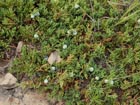Conservation Status

Juniperus horizontalis
Moench 1794
Common names
Creeping juniper, savinier, genévrier horizontal (Adams 1993), Bar Harbor juniper in Maine (V. Dinets, e-mail 2003.10.18).
Taxonomic notes
There are 25 synonyms, although none are really in contemporary use; see POWO for the full list.
Juniperus Section Sabina. Molecular and terpenoid data place J. horizontalis in a clade with the Caribbean junipers J. bermudiana and J. gracilior, within a larger clade that includes J. virginiana, J. scopulorum and J. maritima (Adams 2014, Farjat et al. 2019). Placing J. horizontalis with the Caribbean junipers is biogeographically implausible, but it is well established on both morphological and molecular grounds that J. virginiana and J. scopulorum form a dominant and very widespread North American species complex, with J. horizontalis, J. maritima and the various Caribbean junipers all derived from it. See Adams (2014) for detailed discussion of relationships within this group.
Juniperus horizontalis, a prostrate species, hybridizes with the trees J. virginiana and J. scopulorum (Adams 1983; Fassett 1945) and is closely related to both. The hybrid between J. horizontalis and J. scopulorum is J. × fassettii Boivin, and that between J. horizontalis and J. virginiana is J. × ambigens (Fassett) R.P.Adams. The hybrids occur in areas where both parent species are present, and are distinguished by their shrubby, non-prostrate habit.
Description
"Shrubs dioecious, prostrate to decumbent; crown depressed. Bark brown, exfoliating in thin strips, that of small branchlets (5-10 mm diam.) smooth, that of larger branchlets exfoliating in wide strips or plates. Branches creeping; branchlets erect, 3-4-sided in cross section, ca. 2/3 or less as wide as length of scalelike leaves. Leaves green but turning reddish purple in winter, abaxial gland elliptic, conspicuous, exudate absent, margins entire (at 20× and 40×); whip leaves 4-8 mm, not glaucous adaxially; scalelike leaves 1.5-2 mm, mostly overlapping to 1/3 their length, apex rounded or obtuse to acute and apiculate, spreading. Seed cones mostly maturing in 2 years, of 2 distinct sizes, generally with curved peduncles, globose to ovoid, 5-7 mm, blue-black to brownish blue when mature, lightly glaucous, soft and resinous, with 1-2(-3) seeds. Seeds 4-5 mm. 2n = 22" (Adams 1993). See García Esteban et al. (2004) for a detailed characterization of the wood anatomy.
Distribution and Ecology
Canada: Alberta, British Columbia, Manitoba, New Brunswick, Newfoundland, Northwest Territories, Nova Scotia, Ontario, Québec, Prince Edward Island, Saskatchewan, Yukon; France: St. Pierre and Miquelon; USA: Alaska, Montana, Wyoming, Nebraska, South Dakota, North Dakota, Minnesota, Iowa, Illinois, Wisconsin, Michigan, New York, Vermont, Massachusetts, New Hampshire and Maine; at 0-1000 m on sand dunes, sandy and gravelly soils, prairies, slopes, rock outcrops, and stream banks (Adams 1993). See also Thompson et al. 1999. Hardy to Zone 4 (cold hardiness limit between -34.3°C and -28.9°C) (Bannister and Neuner 2001).
Distribution data. Data sources (click on data points to view) include my observations (accompanied by a list of associated gymnosperm taxa), GBIF (2014; accompanied by name or abbreviation of the collecting institution), Tropicos (2014; accompanied by detailed specimen data), the New York Botanical Garden (2014; accompanied by detailed specimen data), and the Consortium of Pacific Northwest Herbaria (2014; accompanied by detailed specimen data).
Remarkable Specimens
Juniperus horizontalis currently holds the record as the smallest conifer, since I have found cone-bearing individuals only 4 cm tall. Its principal competitor is Lepidothamnus laxifolius, about the same size.
Ethnobotany
No data as of 2022.12.28.
Observations
See the collection records on iNaturalist.
Remarks
The epithet horizontalis refers the prostrate growth habit.
Citations
Adams, Robert P. 1993. Juniperus. Flora of North America Editorial Committee (eds.): Flora of North America North of Mexico, Vol. 2. Oxford University Press. This document is available online. Go to http://www.efloras.org, click on "Flora of North America," and search for "Juniperus."
Adams, Robert P. 2014. Junipers of the World: The Genus Juniperus. Fourth edition. Bloomington, Indiana: Trafford Publishing. Brief versions of the descriptions are available online at Adams's website, www.juniperus.org.
Moench, C. 1794. Methodus plantas horti botanici et agri marburgensis, ... Marburg. (p. 692).
See also
Farjon (2005) provides a detailed account, with illustrations.


